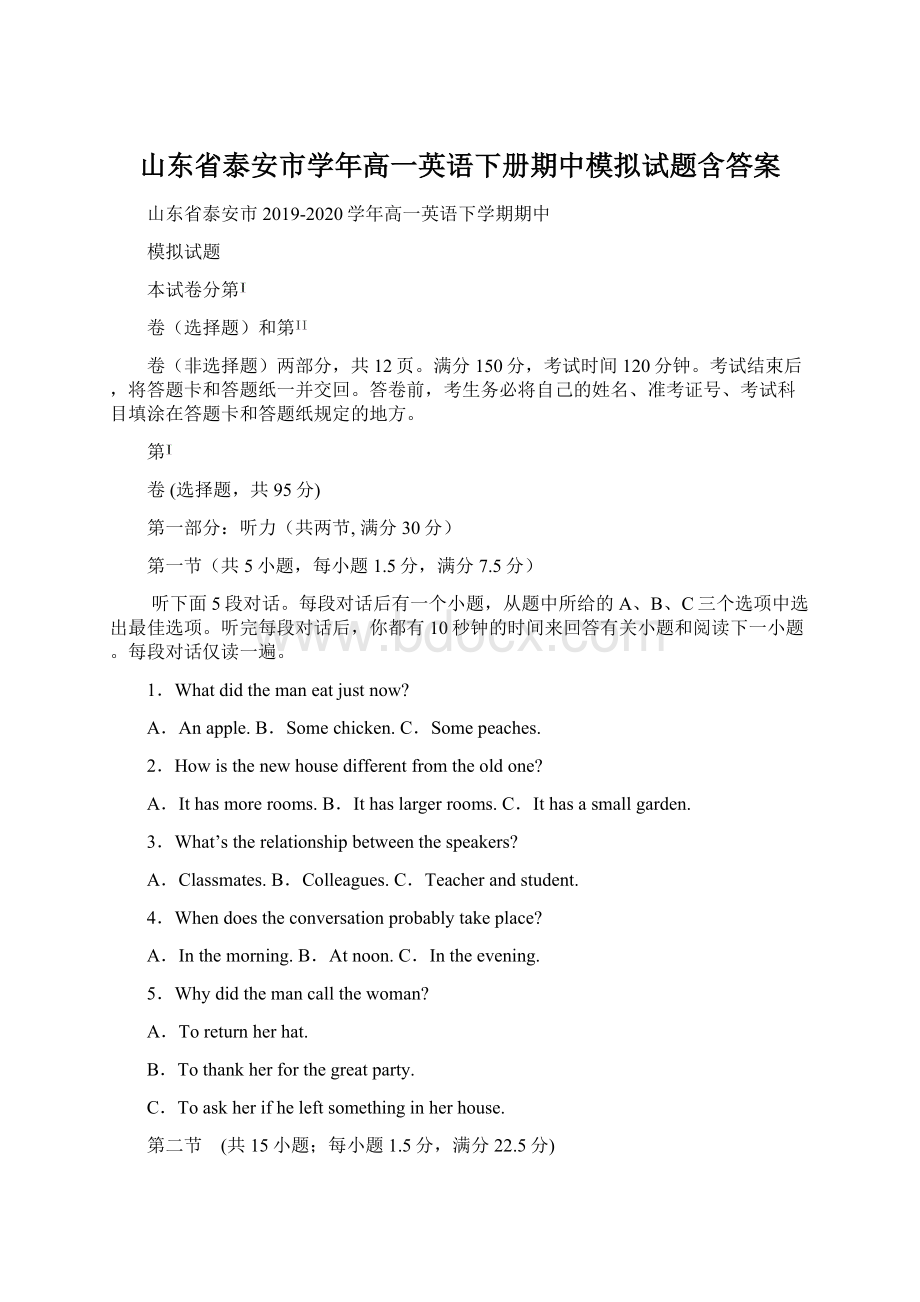山东省泰安市学年高一英语下册期中模拟试题含答案.docx
《山东省泰安市学年高一英语下册期中模拟试题含答案.docx》由会员分享,可在线阅读,更多相关《山东省泰安市学年高一英语下册期中模拟试题含答案.docx(17页珍藏版)》请在冰豆网上搜索。

山东省泰安市学年高一英语下册期中模拟试题含答案
山东省泰安市2019-2020学年高一英语下学期期中
模拟试题
本试卷分第
卷(选择题)和第
卷(非选择题)两部分,共12页。
满分150分,考试时间120分钟。
考试结束后,将答题卡和答题纸一并交回。
答卷前,考生务必将自己的姓名、准考证号、考试科目填涂在答题卡和答题纸规定的地方。
第
卷(选择题,共95分)
第一部分:
听力(共两节,满分30分)
第一节(共5小题,每小题1.5分,满分7.5分)
听下面5段对话。
每段对话后有一个小题,从题中所给的A、B、C三个选项中选出最佳选项。
听完每段对话后,你都有10秒钟的时间来回答有关小题和阅读下一小题。
每段对话仅读一遍。
1.Whatdidthemaneatjustnow?
A.Anapple.B.Somechicken.C.Somepeaches.
2.Howisthenewhousedifferentfromtheoldone?
A.Ithasmorerooms.B.Ithaslargerrooms.C.Ithasasmallgarden.
3.What’stherelationshipbetweenthespeakers?
A.Classmates.B.Colleagues.C.Teacherandstudent.
4.Whendoestheconversationprobablytakeplace?
A.Inthemorning.B.Atnoon.C.Intheevening.
5.Whydidthemancallthewoman?
A.Toreturnherhat.
B.Tothankherforthegreatparty.
C.Toaskherifheleftsomethinginherhouse.
第二节 (共15小题;每小题1.5分,满分22.5分)
听下面5段对话或独白。
每段对话或独白后有几个小题,从题中所给的A、B、C三个选项中选出最佳选项。
听每段对话或独白前,你将有时间阅读各个小题,每小题5秒钟;听完后,各小题将给出5秒钟的作答时间。
每段对话或独白读两遍。
听第6段材料,回答第6至8题。
6.Whereisthemangoing?
A.Ahotel.B.Apark.C.Amuseum.
7.WhydoesthewomansuggestParkStreet?
A.ThereisheavytrafficonMadisonStreet.
B.Itisthefastestway.
C.Sheknowstheroutebetter.
8.Whichwaydothespeakersfinallygo?
A.MadisonStreet.B.ParkStreet.C.50thStreet.
听第7段材料,回答第9至11题。
9.Wheredoestheconversationtakeplace?
A.Inawaitingroom.B.Inthedoctor’soffice.C.Overthephone.
10.What’swrongwiththeman?
A.Hehasastomachache.B.Hehasatoothache.C.Hehasaheadache.
11.Whencanthemanseethedoctor?
A.Rightnow.B.Thisafternoon.C.Tomorrow.
听第8段材料,回答第12至14题。
12.What’stherelationshipbetweenthespeakers?
A.Co�workers.B.Friends.C.Coachandplayer.
13.Whichsportdoesthewomandoforexercise?
A.Running.B.Basketball.C.Swimming.
14.Howoftendoesthewomanplayvolleyball?
A.Twiceaweek.B.Threetimesaweek.C.Everyday.
听第9段材料,回答第15至17题。
15.WhoisBobby?
A.Afriend.B.Adog.C.Aneighbor.
16.WhathappenedtoBobby?
A.Hewentmissing.B.HeleftwithJim.C.Helosthissight.
17.Howdoesthewomanfeel?
A.Angry.B.Worried.C.Regretful.
听第10段材料,回答第18至20题。
18.Whatdoweknowaboutthewoman?
A.Sheisanurse.B.Herhusbandisdead.C.Sheliveswithherchildrennow.
19.Whendoesthewomanusuallygetup?
A.At5:
00.B.At6:
30.C.At7:
00.
20.Whatdoesthewomanlikedoing?
A.Readingnewspapersinthepark.
B.Doingsomethingindoors.
C.Lookingintheshopwindows.
第二部分阅读理解(共两节,满分50分)
第一节(共16小题;每小题2.5分,满分40分)
阅读下列短文,从每题所给的四个选项(A、B、C、和D)中,选出最佳选项,并在答题卡上将该项涂黑。
A
UrbanTransportationinCanada
Publictransportation&Transitpasses
AllcitiesandmostmajortownsinCanadahaveapublictransportationsystemwithoneormoremodesoftransportation(bus,subway,train,etc.).ThebusisthemostcommonformofurbantransportationinCanada.Tousepublictransportation,youmustbuyaticketoratransitpass.Transitpassesallowyouunlimiteduseofpublictransportationforaspecificperiod(onemonthormore).Theyareusuallycheaperthanbuyingmanyticketsifyouplantousepublictransportationoften.
Transportationforpeoplewithdisabilities
Publictransportationoftenhasfeaturestoassistpeoplewithdisabilities.Inmanycitiesandtowns,therearealsotransportationservicesavailablespecificallyforpeoplewithlimitedmobility,suchasspeciallyequippedbuses.Youcanfindoutabouttheseservicesinthesamewayyouwouldlearnmoreaboutotherpublictransportationoptions.
Mannersonpublictransportation
Whentakingpublictransportationsuchasabusortrain,itisimportanttounderstandtheunspokenrulesofconductinthesharedspace.Hereareafewthingstonote:
◆Bepoliteandrespectfultoothersaroundyou.Forexample,maintainanappropriatenoiselevelwhentalkingormakingaphonecall.
◆Ifyouarecarryingabackpackoralargeshoulderbaginacrowdedpublictransitvehicle,keepitclosetoyou,preferablyatyourfeettoavoidhittingpeoplewithitasyouwalkby.
◆Avoidpushingortouchingothersinordertomakemoreroomforyourself.Sometimespublictransitcanbecomeverycrowded,butitisimportanttokeepcalmandgiveothersappropriatepersonalspace.
◆Haveyourproofofpaymentaccessibleincaseyouareaskedtoshowit.
21.Whatistheadvantageofusingtransitpassesoverbuyingtickets?
A.Safertrips. B.Longerservicehours.
C.Moreuseoftransport.D.Lowercosts.
22.Howdoesthetransportationsystemhelppeoplewithdisabilities?
A.Byofferingfewertransportationoptions.
B.Byrunningspecialtransportservices.
C.Bylimitingtheirmobilityoncitybuses.
D.Byprovidingfreeridesintownsandcities.
23.Whatisconsideredimpoliteonpublictransportation?
A.Loweringyourspeakingvoice.
B.Placingbackpacksatyourfeet.
C.Havingyourproofofpaymentathand.
D.Stayingclosetootherpassengers.
B
Manypeoplebelieveeatinghealthilyisexpensive—andmorecostlythanbuyingjunkfoods.Butournewresearch,publishedintheBMCPublicHealth,showsthisisn'tthetruth.
MostoftheAustralianfamilyfoodbudget(预算)isbeingspentonjunkfoodsanddrinksthatarehighinfat,sugarandsalt.
Lessthan7%ofAustralianseathealthily.TheAustralianadultsgetatleast35%oftheirenergyfromjunkfoodsanddrinks.Asaresult,two-thirdsofadults(63%)andone-quarterofchildrenareoverweight.
WeusedtheAustralianHealthSurvey2011-2013andthesuggestionsoftheAustralianDietaryGuidelinestomodelhealthydietsforafamilyoftwoadultsandtwochildreneverytwoweeks.Wecollectedfoodpricesinsupermarketsandstoresinhigh-andlow-socioeconomic(社会经济地位低的)areasinBrisbane,andcomparedthedietpriceswithfamilyincomes.
Inbothareas,afamilyoftwoadultsandtwochildrenspendabout18%moreonpresentdietsthanwouldberequiredtobuyhealthydiets.About58%ofthefoodbudgetforpresentdietsisspentonjunkfoods,includingtakeawayfoods(14%),andsugarydrinks(4%).Inthelow-socioeconomicarea,afamilyoftwoadultsandtwochildrenspend$640.20everytwoweeksontheirpresentdiets,butcouldbuyahealthydietfor$560.93everytwoweeks.Inthehigh-socioeconomicarea,thesenumbersare$661.92and$580.01.
Supermarketfoodpriceswereabout3%higherinthehigh-socioeconomiclocation.Takeawayfoodswerealsorelativelymoreexpensive,butsugarydrinkswerepricedsimilarlyinbothareas.
Presentdietscostmorethanhealthydiets,socausesotherthanpricemustbehelpingtodrivepreferencesforunhealthychoices.
24.Whatdidtheresearchersfind?
A.Australianshaveapreferenceforsweetfoods.
B.MostAustraliankidshavefatproblems.
C.MostAustralianseatunhealthily.
D.HalfAustraliansliveonjunkfoods.
25.Howdidtheresearchersgettheresult?
A.Bydoingthestudyonline.B.Bymakingacomparison.
C.Bycarryingoutinterviews.D.Byaskingpersonalquestions.
26.WhatcanwelearnfromParagraph5?
A.Ahealthydietisactuallycheaper.
B.Australianfoodsarehealthier.
C.Healthfoodsarebecomingmoreexpensive.
D.Peoplechoosejunkfoodsfortheirlowprices.
27.Whatmightafollowingparagraphbeabout?
A.Whypeoplechoosejunkfoods.B.Howwecaneathealthily.
C.Theharmofjunkfoods.D.Theadvantagesofahealthydiet.
C
Mostpeoplearoundtheworldareright-handed.Thisalsoseemstobetrueinhistory.In1799,scientistsstudiedworksofartmadeatdifferenttimesfrom1,500B.C.tothe1950s.Mostofthepeopleshownintheseworksareright-handed,sothescientistsguessedthatright-handednesshasalwaysbeencommonthroughhistory.Today,onlyabout10%to15%oftheworld’spopulationisleft-handed.
Whyaretheremoreright-handedpeoplethanleft-handedones?
Scientistsnowknowthataperson’stwohandseachhavetheirownjobs.Formostpeople,thehandisusedtofindthingsorholdthings.Therighthandisusedtoworkwiththings.Thisisbecauseofthedifferentworkofthetwosidesofthebrain.Therightsideofthebrain,whichmakesaperson’shandsandeyesworktogether,controlsthelefthand.Theleft-sideofthebrain,whichcontrolstherighthand,isthecentreforthinkinganddoingproblems.Thesefindingsshowthatmoreartistsshouldbeleft-handed,andstudieshavefoundthatleft-handednessistwiceascommonamongartistsasamongpeopleinotherjobs.
Noonereallyknowswhatmakesapersonbecomeright-handedinsteadofleft-handed.Scientistshavefoundthatalmost40%ofthepeoplebecomeleft-handedbecausetheirmainbrainisdamagedwhentheyareborn.However,thisdoesn’thappentoeveryone,soscientistsguesstheremustbeanotherreasonwhypeoplebecomeleft-handed.Oneideaisthatpeopleusuallygetright-handedfromtheirparents.Ifapersondoesnotreceivethegene(基因)forright-handedness,he/shemaybecomeeitherright-handedorleft-handedaccordingtothechanceandthepeopletheyworkorlivewith.
Thoughright-handednessismorecommonthanleft-handedness,peoplenolongerthinkleft-handedpeoplearestrangeorunusual.Alongtimeago,left-handedchildrenweremadetousetheirrighthandslikeotherchildren,buttodaytheydon’thaveto.
28.Afterstudyingworksofartmadeatdifferenttimesinhistory,thescientistsfound_______.
A.theartbeganfrom1,500B.C.
B.theworksofartendedinthe1950s
C.mostpeopleshownintheworksofartareleft-handed
D.mostpeopleshownintheworksofartareright-handed
29.Howmanypeopleintheworldareleft-handednow?
A.Morethanahalf.B.Lessthanonesixth.
C.About40%.D.Thepassagedoesn'ttellus.
30.Whatisthehandformostpeopleusedtodo?
A.It’sthecentreforthinkinganddoingproblems.
B.It’susedtoworkwiththings.
C.It’susedtomakeaperson’seyeswo